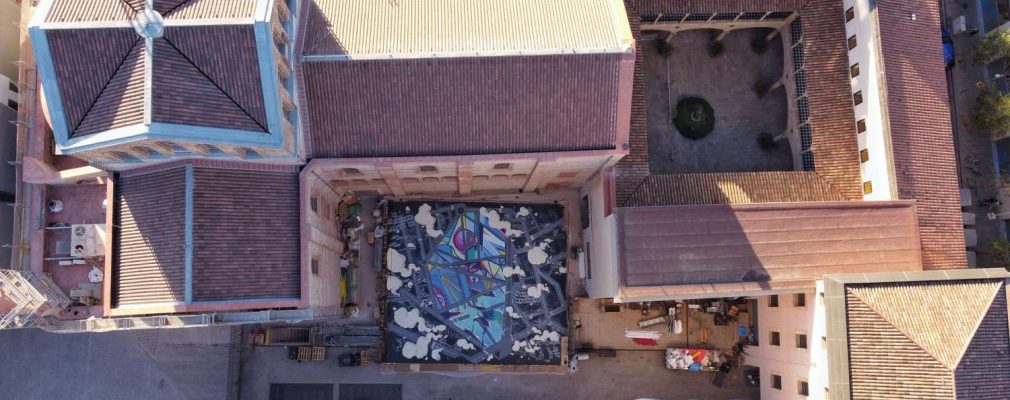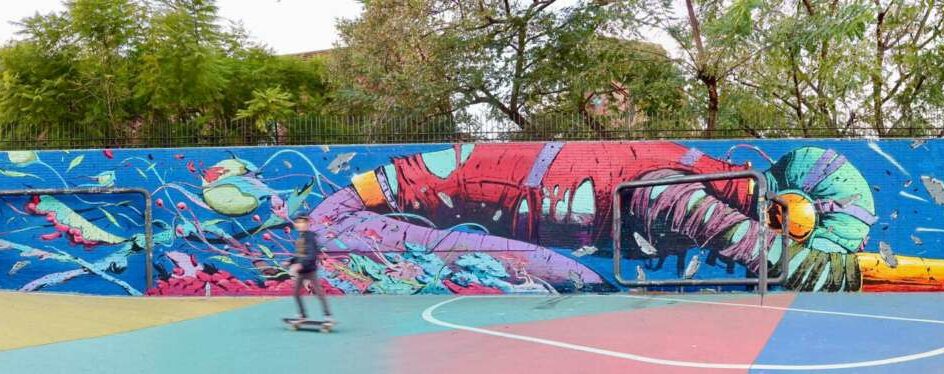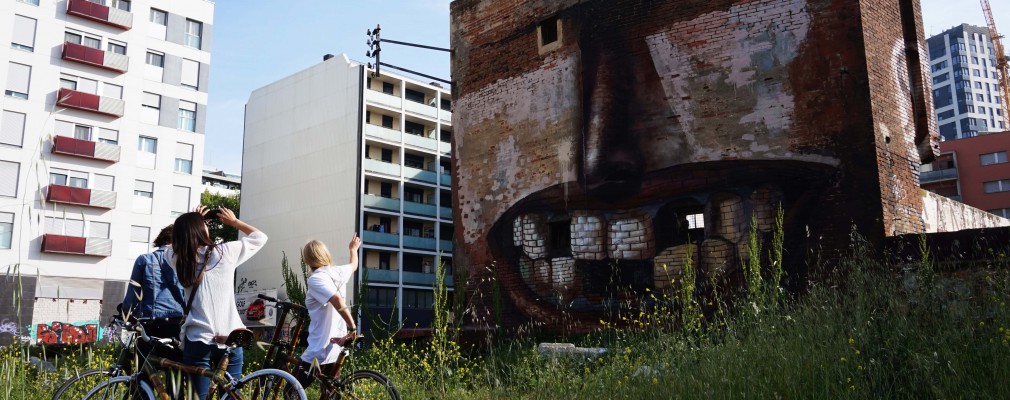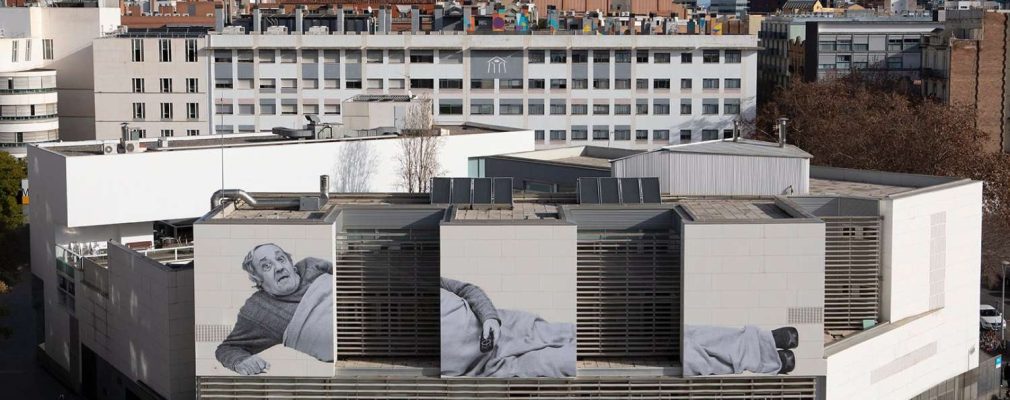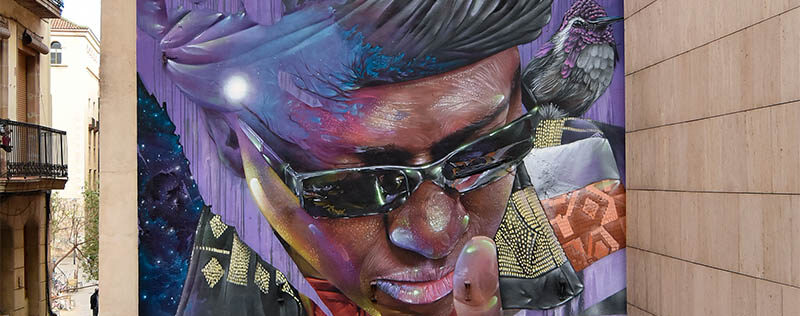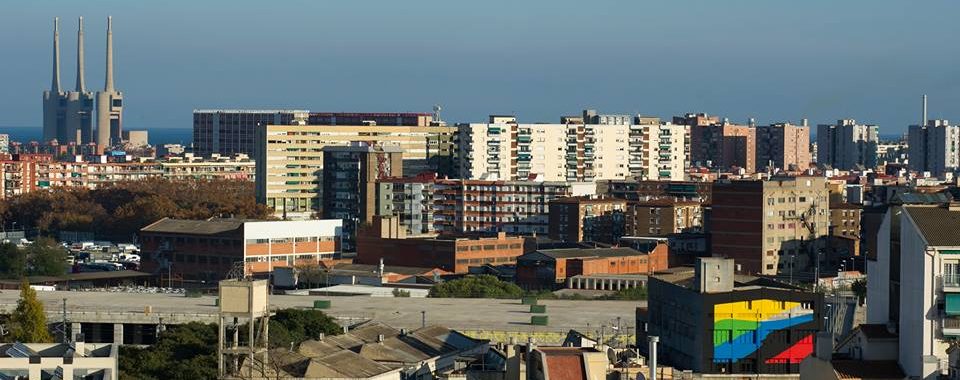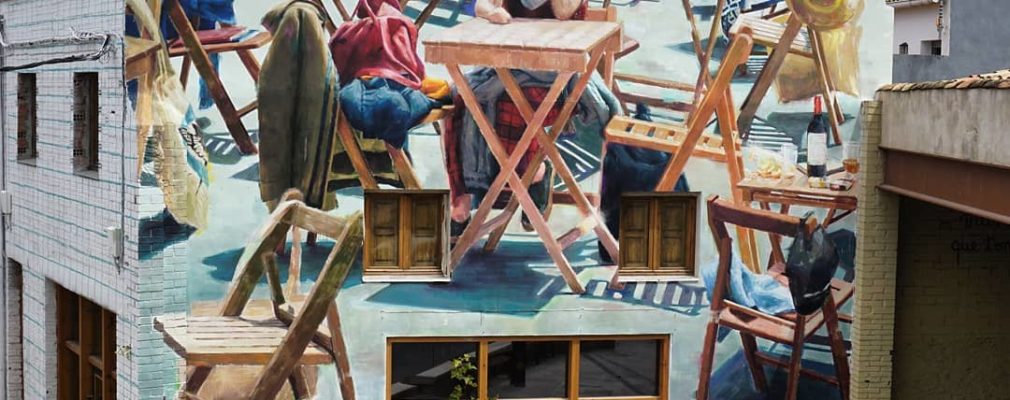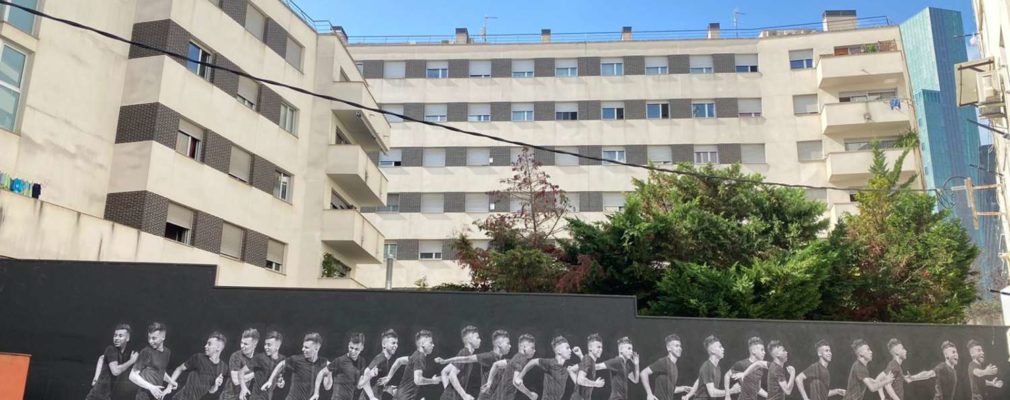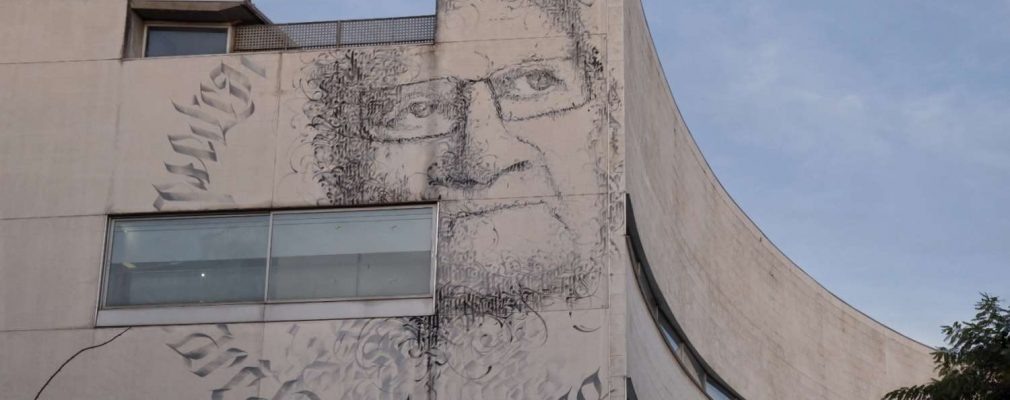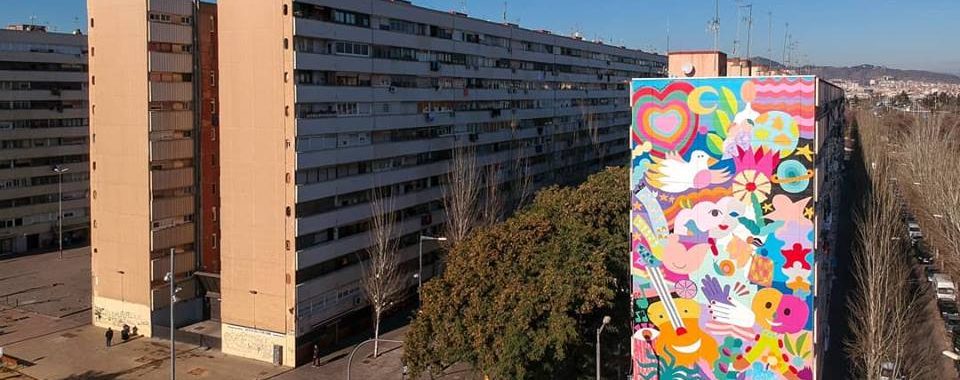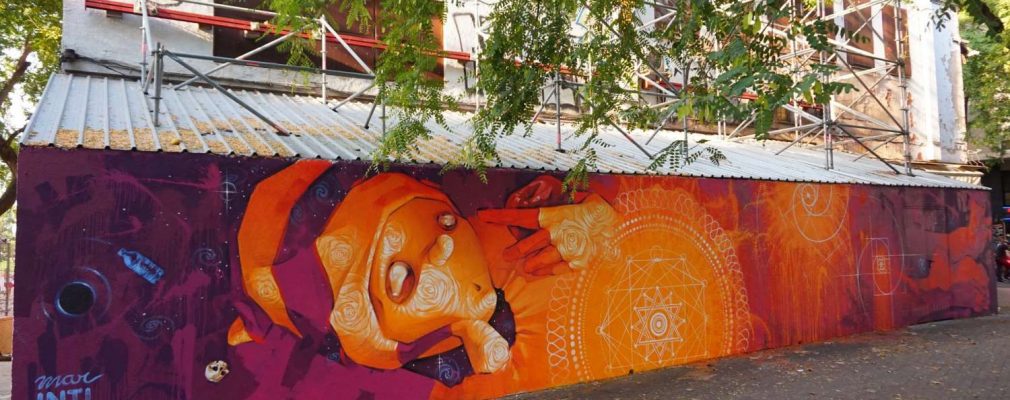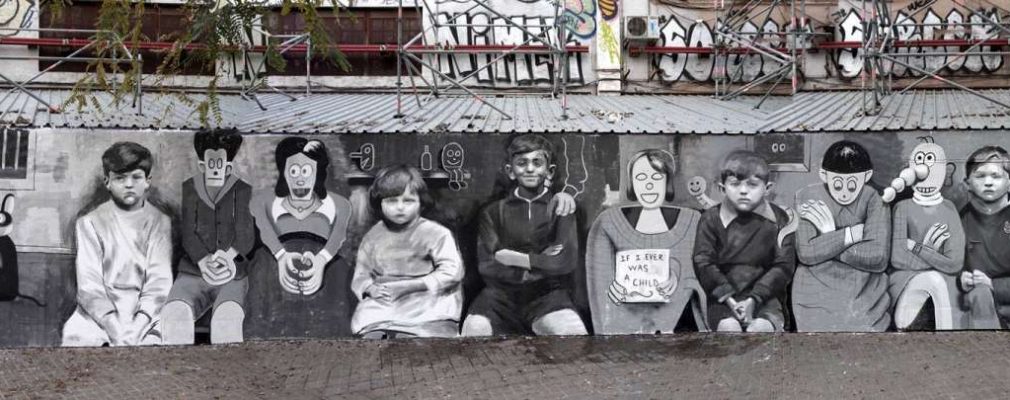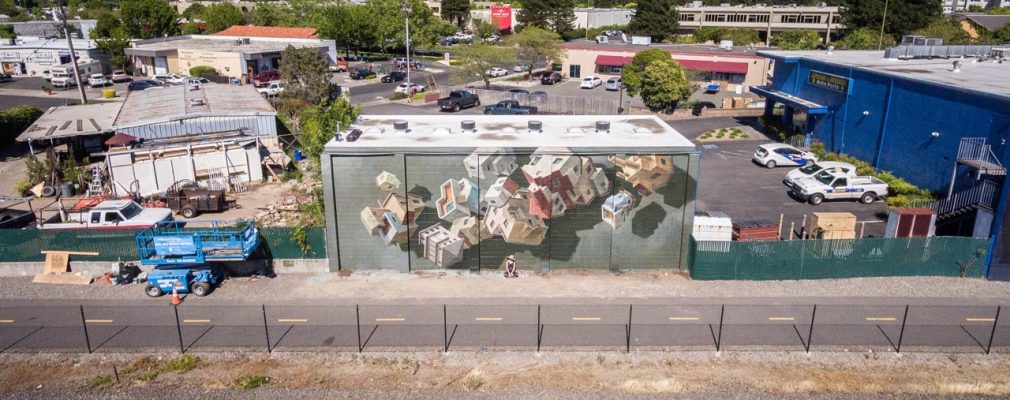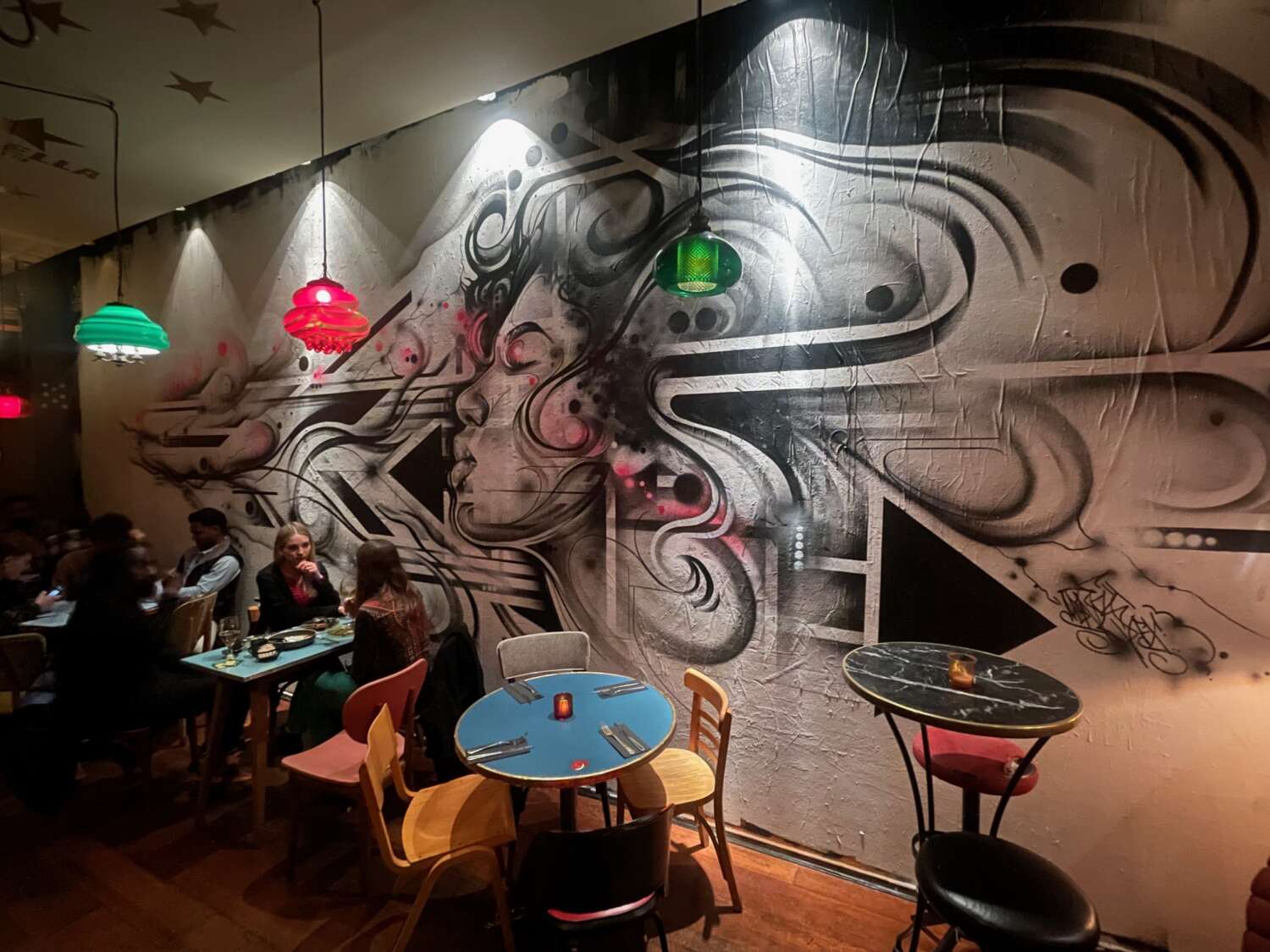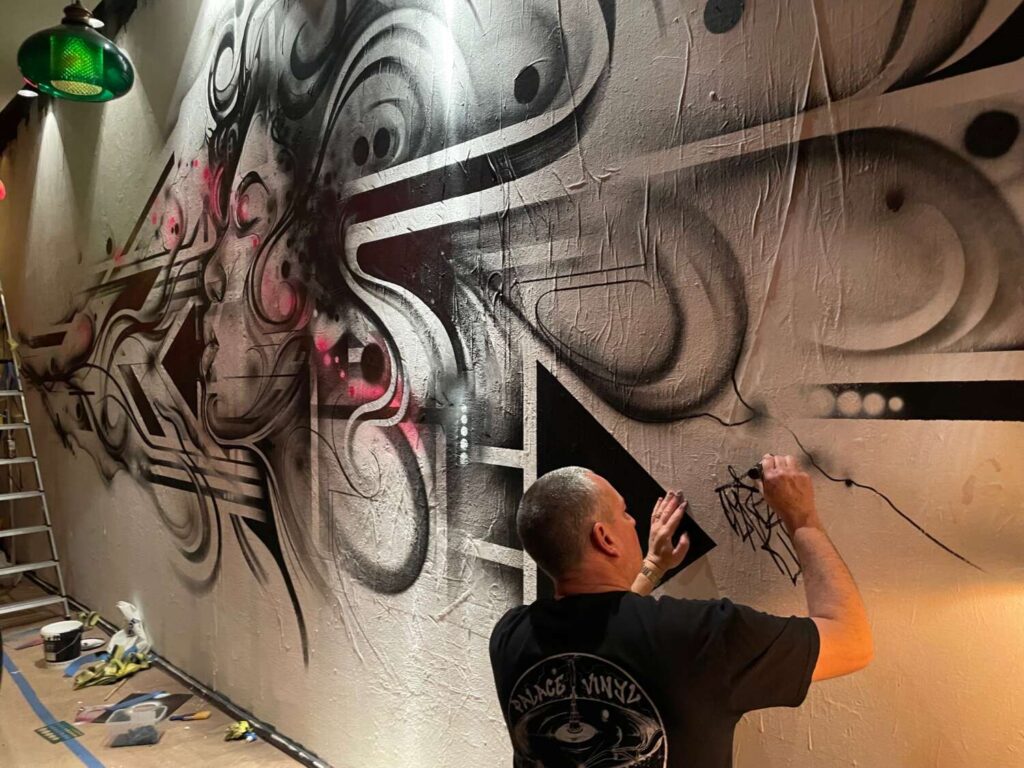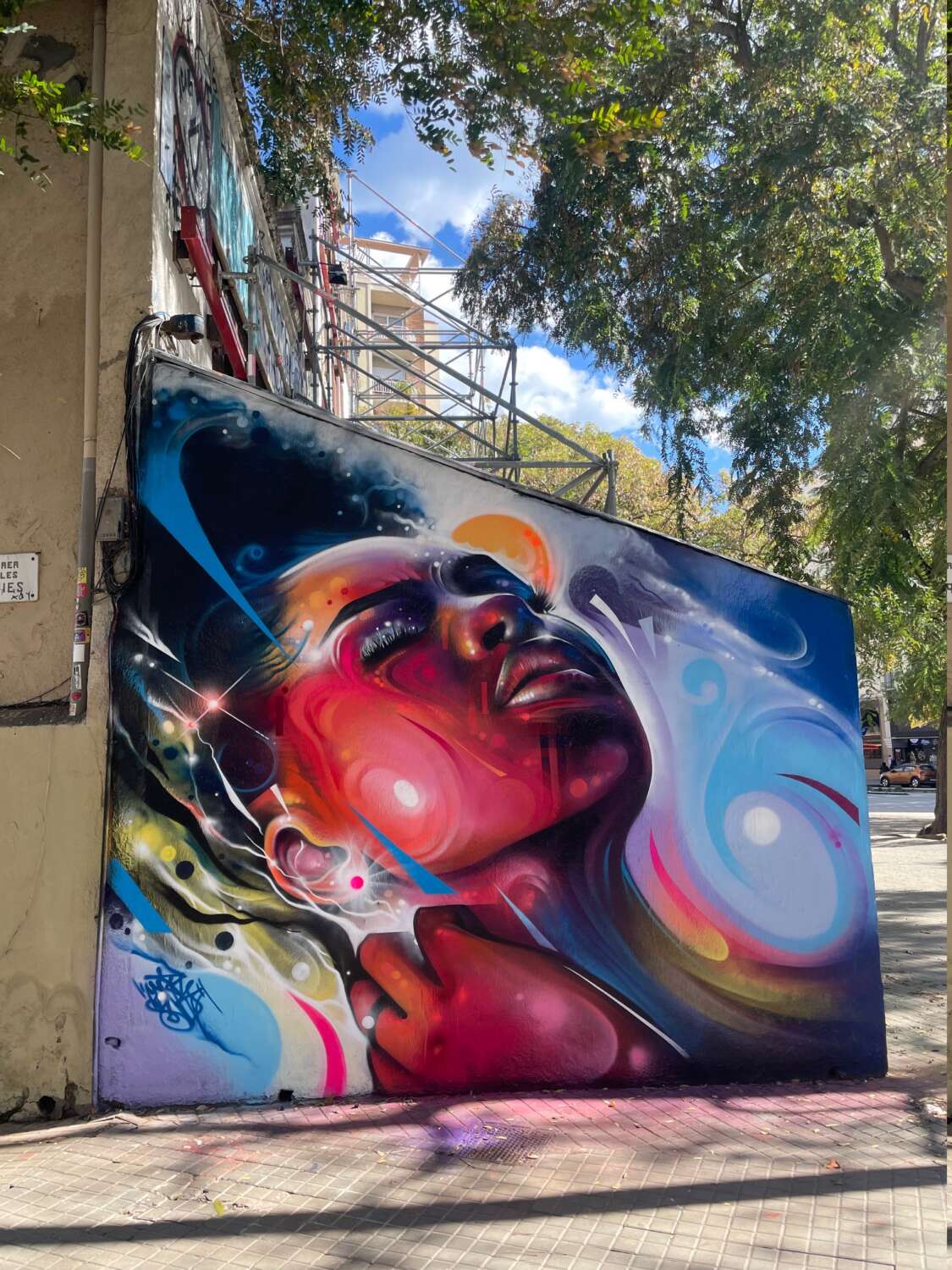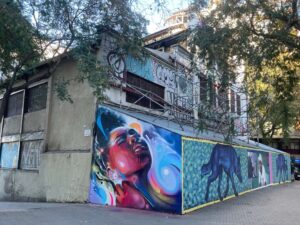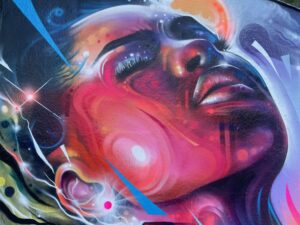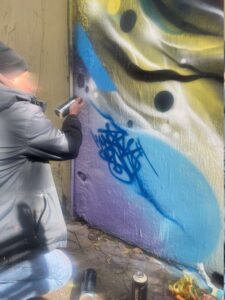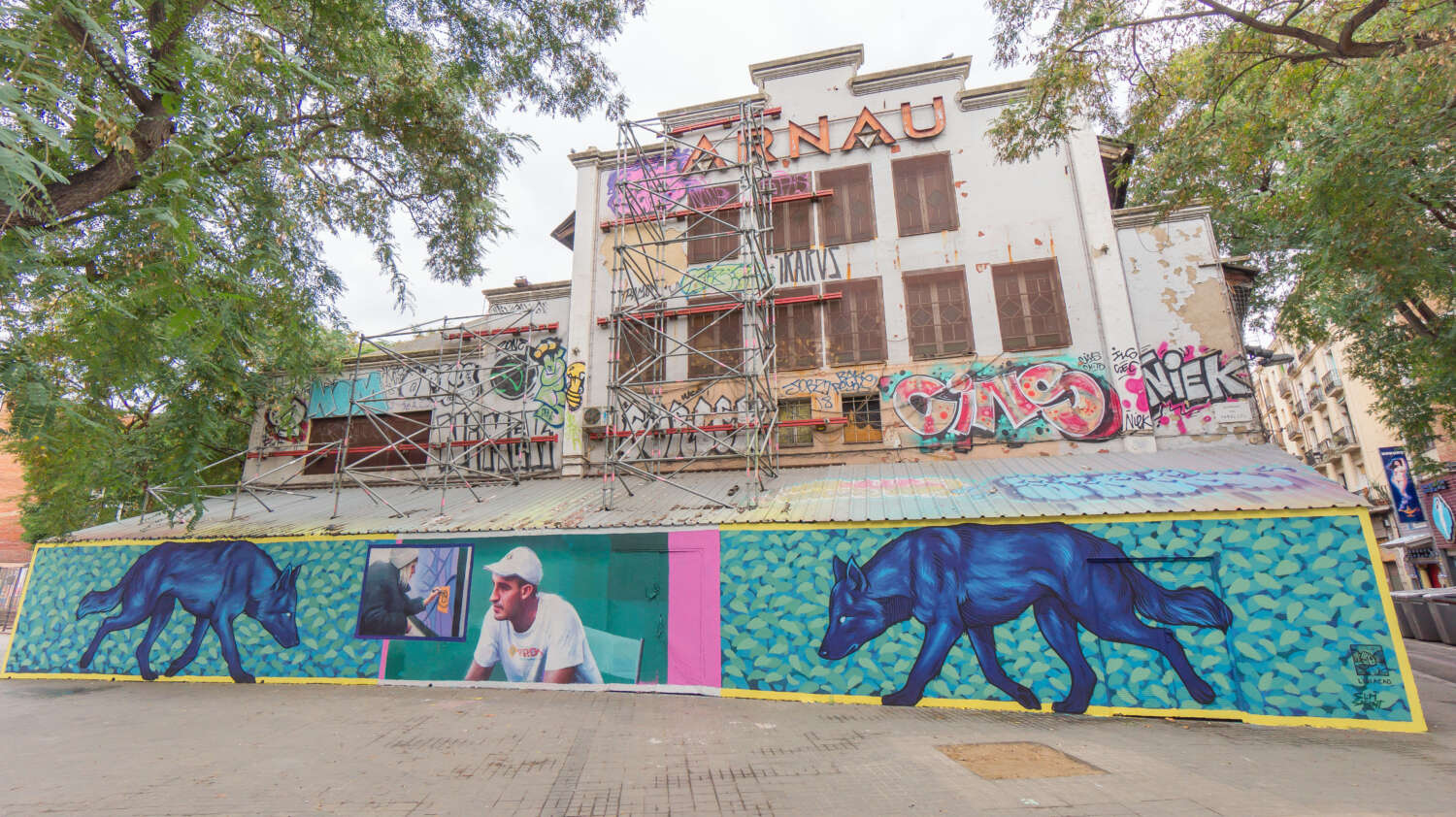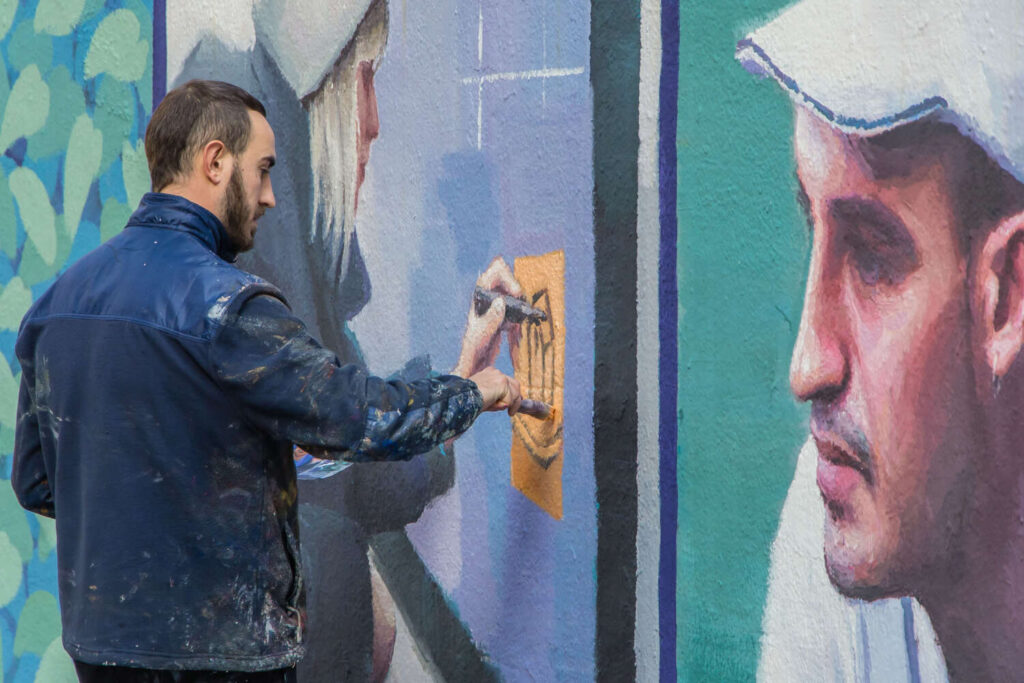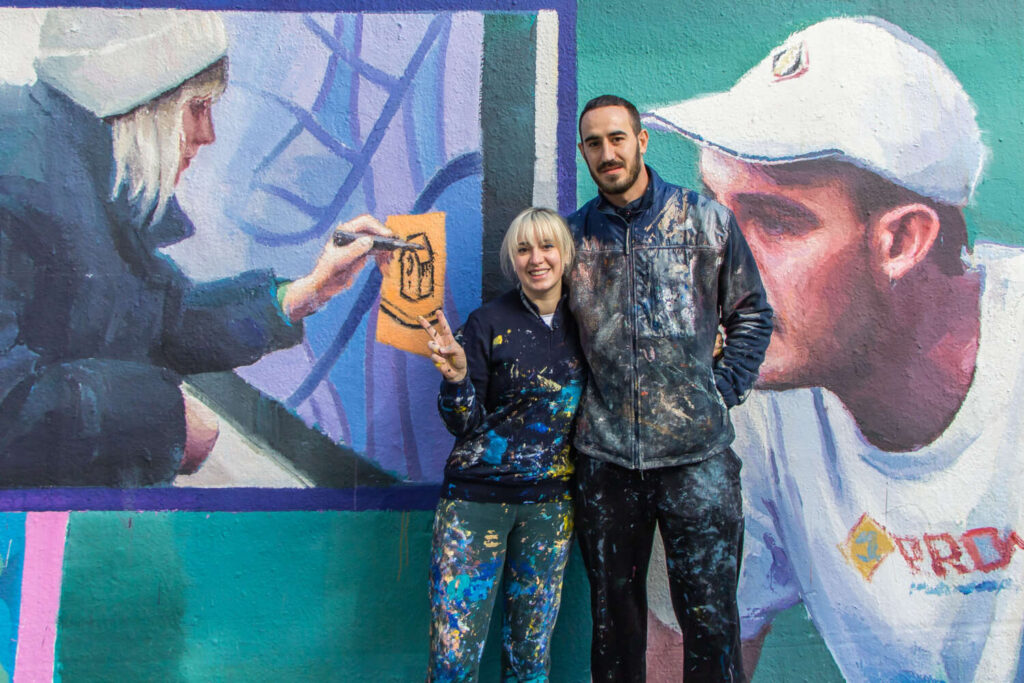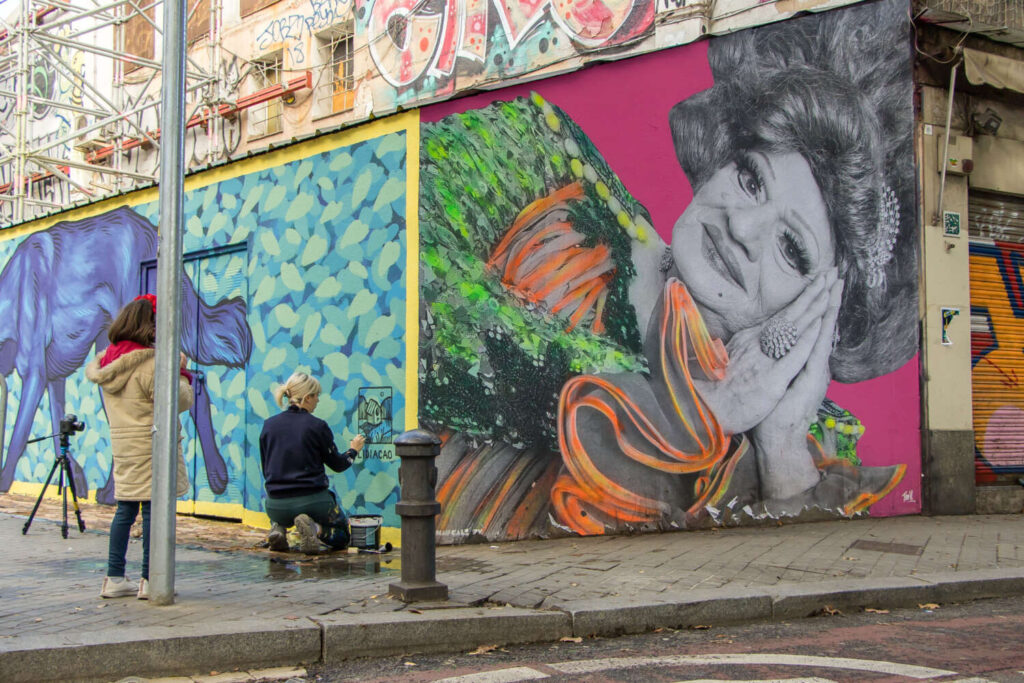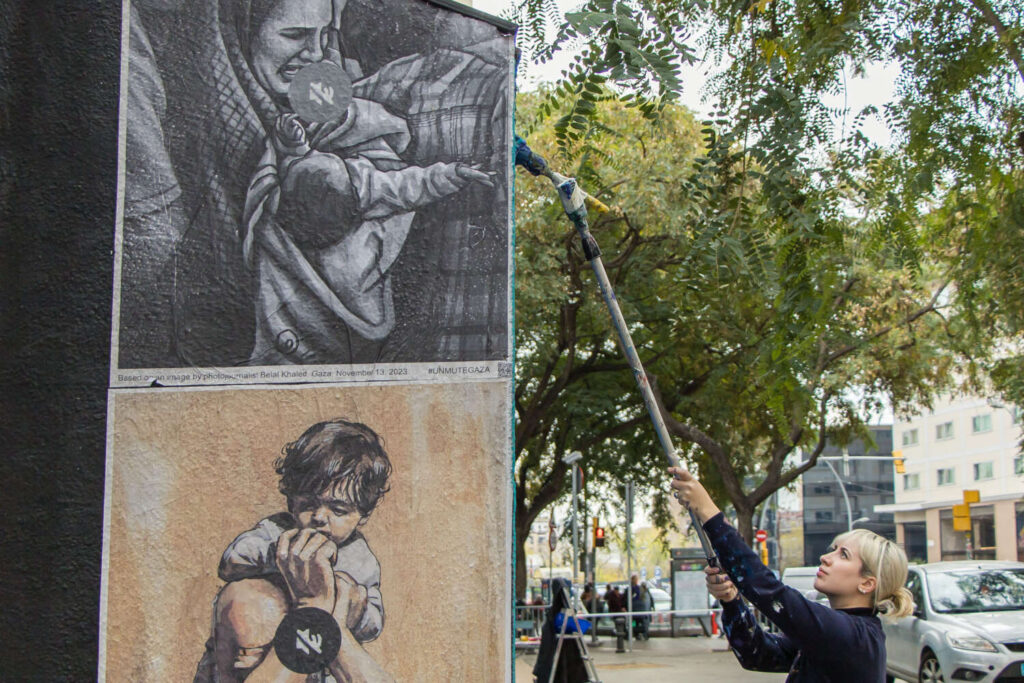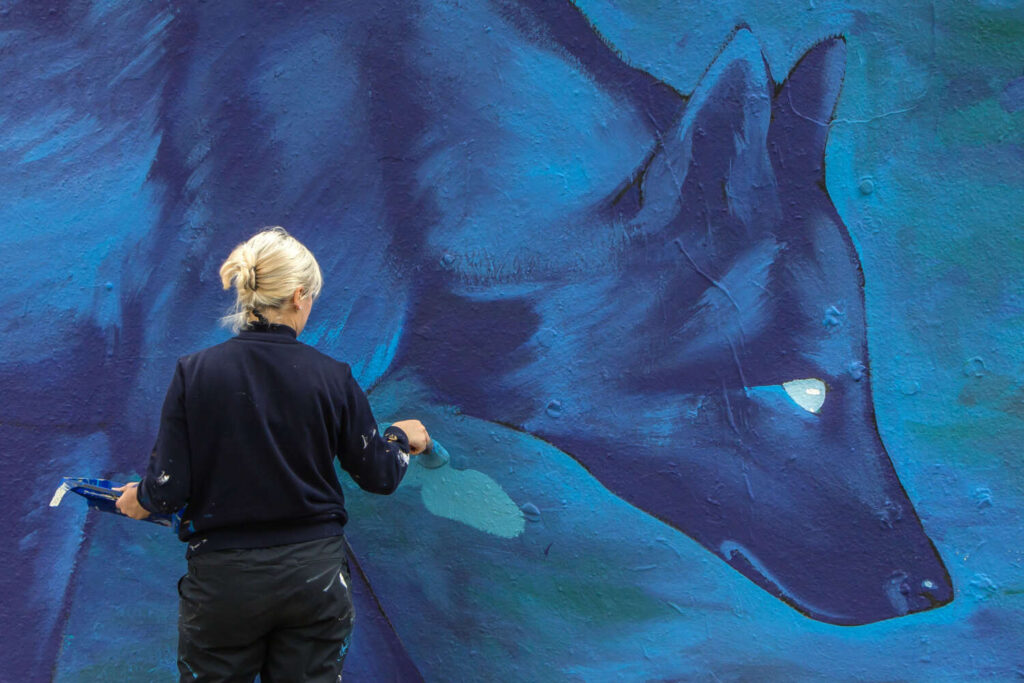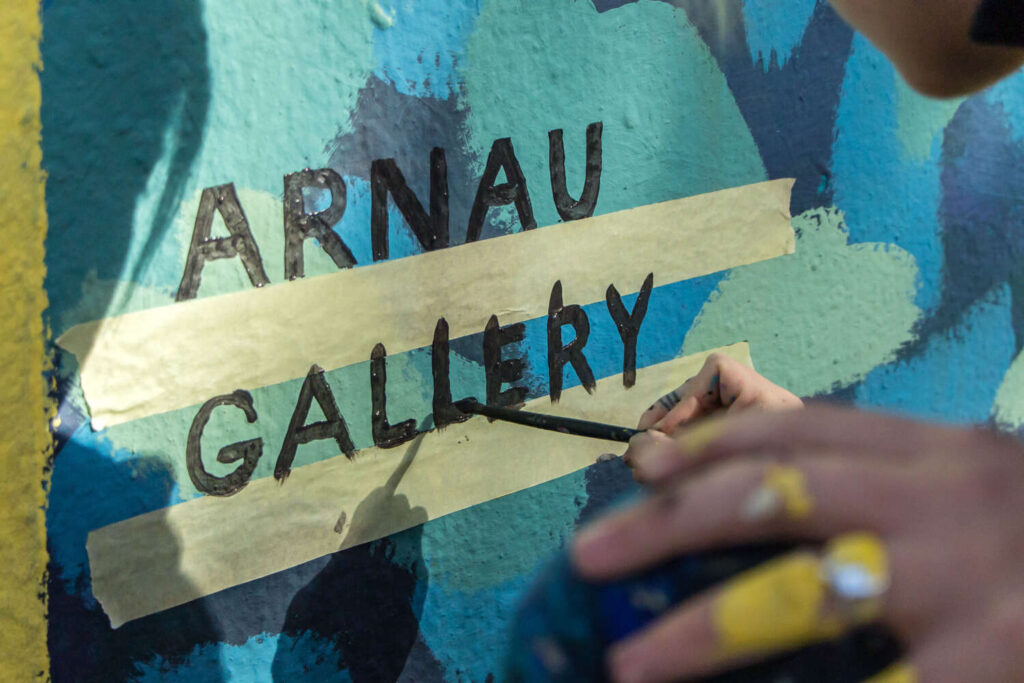The latest street art news, artist interviews, gallery exhibitions and photos from the Barcelona urban art scene.
Street Art Barcelona is a collaborative platform created to support & promote the Barcelona art scene.
Mr Cenz in Barcelona for Guzzo & Arnau Gallery
For our last event at Guzzo, we welcomed Mr Cenz, historical graffiti and street artist from London, who showcased his vibrant and funky style in live. Thanks to everyone who joined!
We also offered him hist first outdoor mural in Barcelona city centre in our very own @arnaugallery.
Thanks to @montana_colors and @montopinturas for the support.
Interview Lidia Cao & Slim Safont X Arnau Gallery
*Interview by Flora Beillouin
*Photos by Laura Colomé
EN + FR below
ES
«El mural es un baile, es gestual, trabajas fuera a partir del contexto del lugar».
Del 15 al 19 de enero, nuestra Galería Arnau acogió al barcelonés Slim Safont y a la gallega Lidia Cao para llevar a cabo un mural a cuatro manos, siguiendo las huellas del neomuralismo.
Esta es vuestra primera colaboración. ¿Os conocíais antes de este encuentro?
Slim – Nos conocimos de camino a un festival, una vez que hicimos un viaje en coche juntos de varias horas.
Lidia – Creo que el primero fue El Asalto, un festival a nivel internacional de arte urbano, y que nos volvimos a ver en Italia, en Taranto…
¿Cómo describiríais el trabajo del otro / de la otra?
Lidia – A mí me encanta el trabajo de Slim, sobre todo porque pictóricamente no estoy acostumbrada. Su realismo, con ese toque de pintura, crea un cuerpo distinto. No se trata sólo de una foto, hay texturas, capas, rayas… Cuando lo observas detenidamente, no sabes bien cómo lo ha hecho y eso me parece interesante.
Slim – Me pasa lo mismo con Lidia. ¡Todo lo que me gustaría tener en mi obra lo tiene ella! Hace un trabajo de línea y de color muy interesante.
¿Qué os hizo querer entrar en el mundo de la pintura?
Slim – Pues empecé a hacer grafitis ilegales, pintando en la calle con otros apasionados, escuchando Hip-Hop. Luego estudié Bellas Artes y me enfoqué más en hacer retratos. Poco a poco, fui haciendo algunos encargos y subí de escala pasando al muro. Ahora es mi oficio…
Lidia – En mi pueblo organizan un festival de arte urbano y me he criado un poco en ese ambiente, yendo a talleres de muralismo. Cuando empecé, era una persona hipertímida… ¡Odiaba que me viesen dibujar! A través de esos cursos, me di cuenta de que me gustaba muchísimo pintar en la calle, porque allí pasa de todo… Plasmas una ilustración y puedes ver a la gente interpretarla desde su mundo interior. Me gusta esta interacción que se genera.
Volviendo a vuestra colaboración, ¿podríais explicar de dónde surge la idea de este mural?
Slim – Arnau Gallery nos propuso trabajar juntos y Lidia me mandó un dibujo de unos lobos. Yo suelo pintar cosas que pasan a mi alrededor, que me llaman la atención. Voy sacando fotos y luego repaso mi archivo, voy mirando los colores, la composición, la luz, y escojo. Al final, ¡uno pinta lo que ve! De una foto que tenía por ahí, surgió la idea de nuestros autorretratos con los lobos acechando a los artistas.
Lidia – Me gusta colaborar con artistas muy distintos porque intento adaptarme a su estilo sin dejar el mío. A la vez, esta improvisación me genera un poco de pánico, pero me saca de mi zona de confort y eso me gusta. Por ejemplo, ahora estos lobos representan el proceso creativo, puede ser la autoexigencia o la presión que una siente cuando pinta en la calle… ¡Aunque este fondo con superposiciones de hojas y luces no estaba previsto! (risas)
En cuanto a vuestras formas de trabajar, ¿seguís explorando otros medios y formatos artísticos?
Slim – El mural es como un baile, es más gestual, trabajas fuera, a partir del contexto del lugar y de sus problemáticas. En el estudio, tienes que buscar dentro de ti lo que quieres contar. Y ahora siento que quiero trabajar más al óleo, en el estudio, preparar exposiciones. Creo que me he cansado de hacer murales. Aparte de lo duro que es físicamente, siento que ya he conseguido lo que buscaba y que, por otro lado, se está acabando una época en el mundo del arte urbano…
Lidia – Mis inicios fueron como ilustradora Yo empecé como ilustradora, me gusta más dibujar que pintar. ¡De hecho, lo sufro un poco! Hay un momento, al pintar murales, donde sientes que no puedes avanzar mucho más… Y por otro lado, estamos en un punto límite donde muchos festivales empiezan a pedirte un boceto antes y casi te imponen hasta la temática. Es un mundo que está pillando una trayectoria con la que no me siento del todo en fase.
¿Qué interacciones tenéis con las personas que viven en los sitios donde pintáis?
Slim – Antes de ir a pintar a un sitio, intento estudiar el territorio, a veces me pongo en contacto con la gente, y cuando llego, saco fotos. Cuando es un proyecto tras otro, intento al menos buscar una idea que sea interesante tanto para los vecinos como para mí.
Lidia – Yo también, me documento antes e intento coincidir proponiendo algo poético. Es importante, porque luego te vas y la gente se queda con la obra. Hay cierta responsabilidad…
Slim – Una vez pinté en un pueblo de Salamanca a unos chicos jóvenes que conocí al llegar. Justo eran los pandilleros del pueblo, así que los abuelos me insultaron, ¡casi tuvimos que parar!
Lidia – Nos pasa a todos, da igual lo que pintes, cómo o dónde. Siempre hay quejas y palabras bonitas. Como estos lobos de aquí, que a algunos les parecerán amenazantes, a otros melancólicos… ¡Yo qué sé!
Para vosotros, ¿qué papel juegan los murales en la ciudad?
Slim – ¡Depende mucho dónde! Si la curaduría es sólida y no duda en defender el discurso del artista delante de las instituciones o si son encargos disfrazados… El muralismo, al ser una manera de recuperar las calles, se encuentra entre estrategias políticas, empresariales, publicitarias. Pues en cualquier lugar, nosotros pintamos en directo, y es interesante que los vecinos vean el proceso de la pintura, muchas veces no están acostumbrados a ello.
Lidia – Cuando intervienes en centros culturales, sientes que cumples una función, al menos a corto plazo. Ves a jóvenes que se abren a la cultura, dejando de lado otras actividades más arriesgadas… ¡Hasta una chica, a quien le di talleres, que ahora se dedica al teatro!
¿Qué imagen tenéis de la escena de street art actual de Barcelona?
Slim – Es una de las más potentes del momento. Cuando viajas en eventos internacionales te lo dicen. Pero Barcelona es una ciudad donde nunca se ha superado la época del grafiti de los 90 donde se bombardeó todo… Los políticos se pusieron muy duros y hay pocas obras de gran tamaño. Por ejemplo, ésta es la segunda vez que pinto en ocho años que llevo viviendo aquí.
Lidia – Hay mucha gente de fuera que vienen a vivir a España para pintar, porque hay una buena dinámica y ¡Galicia no se queda atrás! Pero es verdad que se habla mucho de la «Escuela catalana» porque son los que más destacan a nivel internacional por un estilo más marcado.
Para acabar, ¿con quién os gustaría colaborar en un futuro?
Slim – Quizás con Sebas Velasco o Axel Void, uno de estos grandes que han sido mis referentes desde que empecé en este mundo. Siento que podría aprender mucho, ¡me haría ilusión!
Lidia – Por ser ambiciosa, a mí me encantaría Aryz, Sainer, Lauren aka SquidLicker en Instagram… ¡Vamos, con estos tres, sería el típico sueño que dudas que algún día se cumpla!
————
EN
“The mural is a dance, it is gestural, you work outside of the context of the place.”
From January 15 to 19, our Arnau Gallery project hosted the Barcelona native Slim Safont and the Galician Lidia Cao to carry out a four-handed mural, following in the footsteps of neo-muralism.
This is your first collaboration. Did you know each other before this meeting?
Slim – We met on the way to a festival, once we took a car trip together for several hours.
Lidia – I think the first was El Asalto, an international festival of urban art, and we met again in Italy, in Taranto…
How would you describe each other’s work?
Lidia – I love Slim’s work, especially because pictorially I am not used to it. His realism, with that touch of paint, creates a different body. It’s not just a photo, there are textures, layers, stripes… When you look closely, you don’t really know how he did it and I find that interesting.
Slim – The same thing happens to me with Lidia. Everything I would like to have in my work is there! She does very interesting line and color work.
What made you want to enter the world of painting?
Slim – Well, I started doing illegal graffiti, painting in the street with other enthusiasts, listening to Hip-Hop. Then I studied Fine Arts and focused more on making portraits. Little by little, I made some orders and moved up the ladder to the wall. Now it’s my job…
Lidia – In my town they organize an urban art festival and I have grown up a little in that environment, going to muralism workshops. When I started, I was a hyper-shy person… I hated being seen drawing! Through these courses, I realized that I really liked painting on the street, because everything happens there… You paint an illustration and you can see people interpret it from their inner world. I like this interaction that is generated.
Returning to your collaboration, could you explain where the idea for this mural came from?
Slim – Arnau Gallery proposed that we work together and Lidia sent me a drawing of some wolves. I usually paint things that happen around me, that catch my attention. I take photos and then I review my file, I look at the colors, the composition, the light, and I choose. In the end, you paint what you see! From a photo I had lying around, the idea of our self-portraits arose with the wolves stalking the artists.
Lidia – I like to collaborate with very different artists because I try to adapt to their style without leaving mine. At the same time, this improvisation makes me panic a little, but it takes me out of my comfort zone and I like that. For example, now these wolves represent the creative process, it could be the self-demand or the pressure that one feels when painting in the street… Although this background with superimpositions of leaves and lights was not planned! (laughs)
Regarding your ways of working, do you continue exploring other artistic media and formats?
Slim – The mural is like a dance, it is more gestural, you work outside, from the context of the place and its problems. In the study, you have to search within yourself for what you want to tell. And now I feel that I want to work more in oils, in the studio, preparing exhibitions. I think I’m tired of doing murals. Apart from how hard it is physically, I feel that I have already achieved what I was looking for and that, on the other hand, an era is ending in the world of urban art…
Lidia – My beginnings were as an illustrator I started as an illustrator, I like drawing more than painting. In fact, I suffer from it a little! There is a moment, when painting murals, where you feel that you cannot advance much further… And on the other hand, we are at a limit point where many festivals begin to ask you for a sketch beforehand and almost impose the theme on you. It is a world that is taking a trajectory with which I do not feel completely in phase.
What interactions do you have with the people who live in the places where you paint?
Slim – Before going to paint somewhere, I try to study the territory, sometimes I get in touch with people, and when I arrive, I take photos. When it’s one project after another, I try to at least look for an idea that is interesting to both the neighbors and me.
Lidia – Me too, I research beforehand and try to agree by proposing something poetic. It’s important, because then you leave and people keep the work. There is some responsibility…
Slim – I once painted some young boys that I met when I arrived in a town in Salamanca. They were just the town’s gang members, so the grandparents insulted me, we almost had to stop!
Lidia – It happens to all of us, it doesn’t matter what you paint, how or where. There are always complaints and nice words. Like these wolves here, which to some will seem threatening, to others melancholic… What do I know!
For you, what role do murals play in the city?
Slim – It depends a lot on where! If the curatorship is solid and does not hesitate to defend the artist’s discourse in front of the institutions or if they are disguised commissions…
————
FR
“Le muralisme est une danse, il est gestuel, tu travailles à partir du contexte d’un lieu”.
Du 15 au 19 janvier, notre galerie Arnau a accueilli le Barcelonais Slim Safont et la Galicienne Lidia Cao pour une peinture murale à quatre mains, dans la lignée du néo-muralisme.
Vous connaissiez-vous avant cette rencontre ?
Slim – Nous nous sommes rencontrés lors d’un festival, où on a partagé un voyage de plusieurs heures en voiture.
Lidia – Je crois que le premier était El Asalto, et puis on s’est revus en Italie, à Taranto…
Comment décririez-vous le travail de l’autre ?
Lidia – J’adore le travail de Slim, car je n’y suis pas habituée d’un point de vue pictural. Son réalisme, avec cette touche de peinture, crée un corps différent, ce n’est pas juste une photo, il y a des textures, des couches, des rayures… Quand on le voit, on ne sait pas comment il l’a fait, et je trouve cela intéressant.
Slim – C’est la même chose avec Lidia : tout ce que j’aimerais avoir dans mon travail, elle l’a ! Le travail des lignes et des couleurs est très intéressant.
Qu’est-ce qui vous a poussés à vous lancer dans la peinture ?
Slim – J’ai commencé à faire des graffitis illégaux, à peindre dans la rue avec des passionnés en écoutant du hip-hop. Puis j’ai fait les beaux-arts et je me suis concentré sur le travail du portrait. Petit à petit, j’ai répondu à des commandes et j’ai changé d’échelle en passant au grand format, puis au mur. Aujourd’hui, c’est devenu mon métier…
Lidia – Dans mon village, on organise un festival d’art urbain et j’ai grandi dans cet environnement, en participant à des ateliers. Quand j’ai commencé, j’étais très timide, je détestais qu’on me regarde dessiner ! Grâce aux cours, je me suis rendu compte que j’adorais peindre dans la rue, parce que c’est un espace où tout peut arriver… Vous créez une illustration en direct et vous voyez les gens l’interpréter à travers leur monde intérieur, j’aime cette interaction.
Pouvez-vous nous expliquer d’où est venue l’idée de cette peinture murale ?
Slim – La Arnau Gallery nous a demandé de travailler ensemble et Lidia m’a envoyé un dessin avec des loups. Je peins généralement des choses qui se passent autour de moi, que j’aime. Je prends des photos, puis je consulte mes archives, je regarde les couleurs, la composition, la lumière, et je choisis. Au final, on peint ce que l’on voit ! C’est à partir d’une de mes photo qu’est venue l’idée de peindre nos autoportraits encerclés par les loups, comme s’ils traquaient les artistes.
Lidia – J’aime les collaborations car j’essaie de m’adapter au style de l’autre sans délaisser le mien. Cette improvisation me panique toujours un peu, mais ça me pousse à sortir de ma zone de confort. Par exemple là, ces loups représentent le processus créatif, cela peut être l’exigence ou la pression qu’on ressent quand on peint dans la rue… Mais ce fond n’était pas prévu !
Continuez-vous à explorer d’autres supports artistiques ?
Slim – La peinture murale est comme une danse, c’est très gestuel, on travaille à l’extérieur, à partir du contexte du lieu et de ses problématiques. Dans l’atelier, il faut chercher à l’intérieur de soi ce qu’on veut dire. Et maintenant, je sens que je veux travailler davantage à l’huile, en atelier, pour préparer des expositions. Je crois que je suis fatigué de la peinture murale. Au-delà de la difficulté physique, j’ai l’impression d’avoir atteint ce que je cherchais et qu’une époque se termine…
Lidia – J’ai commencé comme illustratrice, je préfère le dessin à la peinture. Je dirai même que la peinture me fait souffrir un peu ! Il y a un moment, en peinture murale, où l’on sent que l’on ne peut pas aller plus loin… Par ailleurs, on arrive à un point limite où beaucoup de festivals commencent à te demander un croquis préalable et t’imposent presque le thème. C’est un monde qui prend une trajectoire avec laquelle je ne me sens plus très en phase.
Quelles interactions avez-vous avec les habitant.es des lieux où vous peignez ?
Slim – Avant de me rendre à un endroit pour peindre, j’essaie d’étudier le territoire, parfois j’entre en contact avec les gens, et quand j’arrive, je prends des photos. Lorsque les projets s’enchaînent trop j’essaie au moins de trouver une idée qui soit intéressante à la fois pour les voisins et pour moi.
Lidia – Moi aussi, je me documente avant et j’essaie de faire coïncider ce que je comprends avec mes idées pour proposer quelque chose de poétique. C’est important parce qu’ensuite nous on s’en va et les gens restent cohabiter avec l’œuvre. On a une certaine responsabilité…
Slim – Une fois, j’allais peindre dans un village de Salamanque et j’ai fait le portrait de jeunes que j’avais rencontrés à mon arrivée. C’étaient la bande qui foutait le bordel au village, les grands-parents se sont mis à m’insulter, on a failli tout arrêter !
Lidia – Ça nous arrive à tous, peu importe où tu peins et ce que tu peins. Il y a toujours des gens qui se plaignent et des mots gentils. Comme ces loups ici, qui sembleront peut-être menaçants pour certains, mélancoliques pour d’autres, va savoir !
Pour vous, quel rôle jouent les fresques aujourd’hui dans la ville ?
Slim – Ça dépend beaucoup de l’endroit ! Si le commissariat est capable de défendre le discours de l’artiste devant les institutions ou s’il s’agit de commandes déguisées… Le muralisme, comme c’est une manière de se réapproprier la rue, c’est à la croisée des stratégies politiques, commerciales et publicitaires. Donc au milieu de tout ça, nous on peint en direct, et c’est intéressant pour les voisins d’être témoins de ce processus, car souvent ils ne sont pas habitués.
Lidia – Quand on intervient dans les centres culturels, on a l’impression de remplir une fonction, au moins à court terme. On voit des jeunes s’ouvrir à la culture, délaisser d’autres activités plus risquées… Une ado que j’ai eu en atelier a même décidé de se lancer dans des études de théâtre !
Quelle image avez-vous de la scène actuelle du street art à Barcelone ?
Slim – C’est l’une des plus puissantes du moment. Quand tu voyages dans des événements internationaux, les gens te le disent. Mais Barcelone est une ville qui ne s’est jamais remise de l’époque du graffiti des années 90 où tout a été bombardé… Les politiques se sont durcies et il y a peu d’œuvres d’envergure dans la ville. Pour donner une idée, c’est seulement la deuxième fois que je peins depuis huit ans que je vis ici.
Lidia – Il y a beaucoup de gens de l’étranger qui viennent vivre en Espagne pour peindre, car il y a une bonne dynamique – d’ailleurs la Galice n’est pas en reste ! Mais c’est vrai qu’on parle beaucoup de ” l’école catalane “, car elle se distingue au niveau international avec un style marqué.
Avec qui aimerais-tu collaborer à l’avenir ?
Slim – Peut-être avec Sebas Velasco ou Axel Void, une de mes références depuis mes débuts. Je sens que je pourrais apprendre beaucoup, je serais content !
Lidia – Pour être ambitieuse, j’aimerais bien Aryz, Sainer ou Lauren, aka SquidLicker sur Instagram… Allez, avec ces trois-là, ce serait typiquement le rêve impossible à réaliser !
Recent artworks
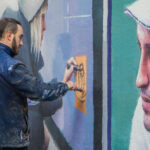
Interview Lidia Cao & Slim Safont X Arnau Gallery
*Interview by Flora Beillouin *Photos by Laura Colomé EN + …Read More »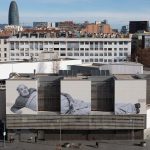
VISIBLES – 13 new murals by Teo Vazquez in Barcelona
The latest project by photographer and paste-up artist Teo Vazquez …Read More »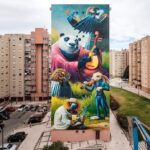
“String Quintet” – Massive mural by Juanjo Surace in Lisboa for MuroLX2021
This summer we’ve been participating in the organisation of the …Read More »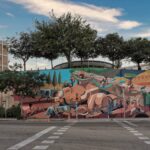
New mural by Franco Fasoli in Trinitat Nova, Barcelona
New mural in Barcelona by the Argentinan artist Franco Fasolijaz, …Read More »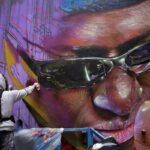
New mural by Conse in Raval – Homage to Makha Diop
At the end of April of this year, a new …Read More »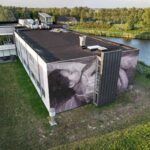
Elisa Capdevila for The Crystal Ship 2020 – Ostend, Belgium
In 2016, The Crystal Ship dropped anchor in the city …Read More »
’20 METROS’ – Última intervención de Teo Vázquez para Mural/Local
Ese mes de Septiembre, el artista Teo Vázquez ha sido …Read More »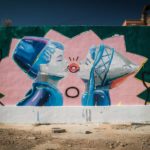
New mural by Ana Barriga for B-Murals
At the end of February, our friends from B-Murals presented …Read More »
The Root – Muralism & Spirituality by Magda Cwik in Mexico City
The Polish and Barcelona-based artist Magda Cwik has been travelling …Read More »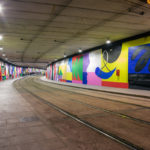
Massive new mural by Murone for Tram Barcelona
At the beginning of 2020, the street artist from Canary …Read More »
Recent blog posts & News
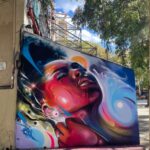
Mr Cenz in Barcelona for Guzzo & Arnau Gallery
For our last event at Guzzo, we welcomed Mr Cenz, …Read More »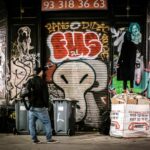
Rumble in Raval
Article by David Davis Barcelona is well renowned in the …Read More »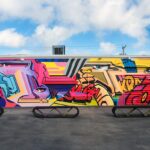
Live Painting Pro 176: Inmersión psicodélica en el Guzzo
ES Artista francés residente en Valencia (España), Pro 176 tiene …Read More »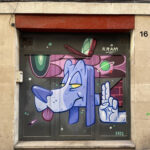
Jam in Sant Pau del Parc & shutters session in Santa Madrona: The Raval reveals its colors
By Anaïs Bertrand ES El 29 de mayo de 2023 …Read More »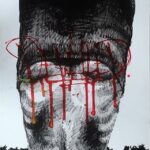
Inauguración de la Arty Love Gallery en Barcelona
ESPAÑOL Inauguración de la Arty Love Gallery en Barcelona La …Read More »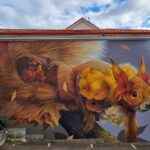
Curtis Hylton live painting in Barcelona
Para nuestro nuevo live painting, volvemos en a casa en …Read More »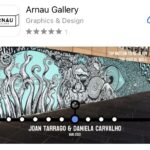
New application Arnau Gallery by Luzidlab
In collaboration with Street Art Barcelona, Luzidlab created the first …Read More »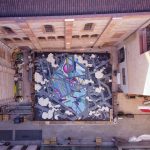
When urban art enters Liceu Opera to pay tribute to Raval
EN For more than two years the legendary Gran Teatre …Read More »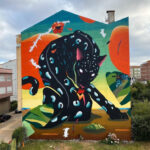
New live painting by Sabek in Guzzo
El mural central del Guzzo vuelve a mutar, esta vez …Read More »
Freedom of speech in Spain – Struggle for the case of Pablo Hasel
Via Inspiring City Street artists in Barcelona have been showing …Read More »
